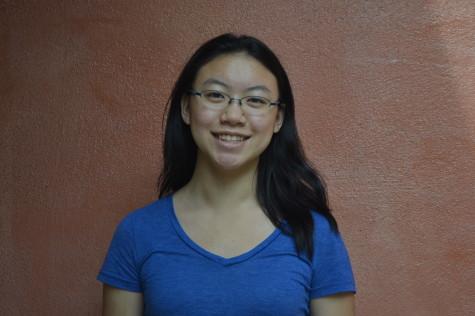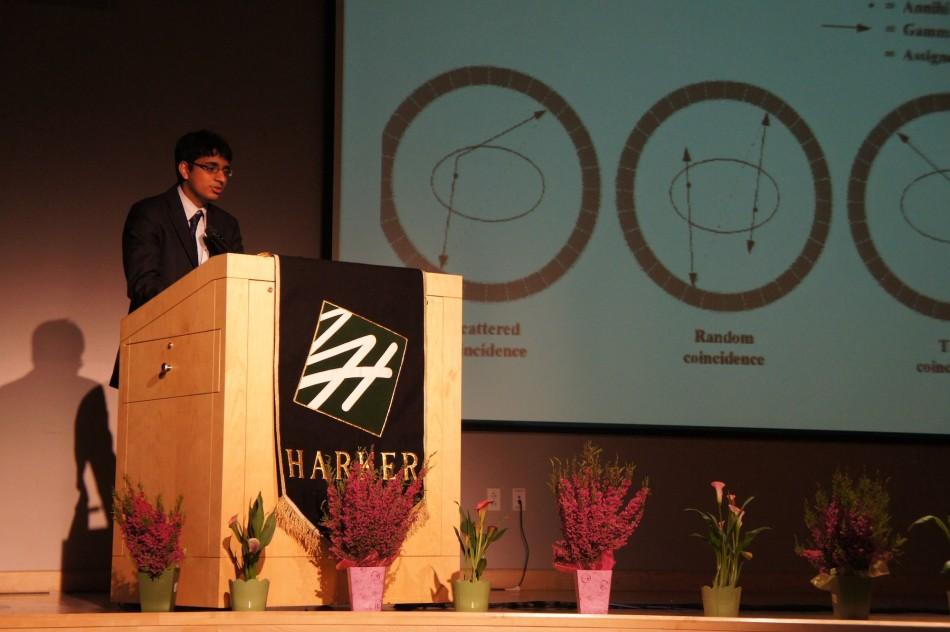Intel finalist presents at capital
Senior Sreyas Misra’s very first research project spent him hours hunched over a laptop or in a lab. After months of work, it would take him as far as the nation’s capital.
As an Intel Science Talent Search finalist, Sreyas presented his work with other student researchers from March 6 to 12 at Washington, D.C. After setting up his poster, he spent the first couple days sightseeing and touring the capitol and had the opportunity to meet with President Barack Obama. The following days consisted of presenting his poster to judges and to the public at various science fairs.
The judge’s questions stood out the most for Sreyas. The questions he received covered topics ranging from potato cells to insulin dosages for diabetic patients undergoing brain surgery.
“They try and see how you think because you’re not expected to know the answer directly. It’s more like you have to go through multiple logical steps before you can arrive at the solution,” he said. “It’s basically trying to see if you can do the scientific method in real-life situations.”
His experiences with other finalists and with judges sparked his interest in a broader range of topics.
“Every time I finished the interview, I would go up to my room on my computer and start looking up all the answers for the questions I just had,” he said. “I would read about random science topics on stuff like semiconductors and things like that just so I could be well-versed in a lot of the recent developments in science.”
His project focused on using alternative imaging techniques to reduce the size of positron emission tomography (PET) scanners, which physicians use to monitor and diagnose diseases like cancer. The currently room-sized equipment poses a significant cost. By designing a hand-held device that can achieve the same function, Sreyas hopes to allow hospitals more access to medical imaging.
“When you make technology a lot smaller, you start to change how it’s used in the hospital. For example, you can’t bring a room-sized PET scanner into the OR, but you can bring a hand-held scanner into the surgery room to aid the surgeon,” he said.
One of the challenges Sreyas faced during his project involved applying the programming he had learned from school to practical uses.
“A lot of these real-world constraints on programming that I never really had in the classroom started to become an issue in the lab, so that was a big learning experience for me,” he said.
Sreyas began his research during the summer before junior year and conducted the majority of his work in the summer before senior year. After spending between 400 and 500 hours in the lab, Sreyas continued research at home and during the school year.
“The day until I submitted my project, I was doing new research,” he said.
Through his research, Sreyas came to appreciate engineering and math on a greater level.
“I wish I took a lot more math courses in high school because what I started to realize in my project is that if you don’t have good math knowledge, it’s really hard to gain intuition to apply in engineering problems,” he said.
Sreyas plans to continue his research as an undergraduate at Stanford University. The next steps involve applying to the National Institutes of Health (NIH) for a grant to physically build the scanner.
“One big issue in my project was that I did not have that validation step of actually building my scanner to test my results in real life and see if my predicted results matched my actual results, and that’s what a lot of the other projects had.”
Sreyas hopes to pursue bioengineering for his undergraduate major and ultimately follow a career in medicine.
This article was originally published in the pages of the Winged Post on April 4, 2014.

Kacey Fang (12) is the Managing Editor for The Winged Post. She has been part of the journalism program since freshman year and served as Features Editor...


















![“[Building nerf blasters] became this outlet of creativity for me that hasn't been matched by anything else. The process [of] making a build complete to your desire is such a painstakingly difficult process, but I've had to learn from [the skills needed from] soldering to proper painting. There's so many different options for everything, if you think about it, it exists. The best part is [that] if it doesn't exist, you can build it yourself," Ishaan Parate said.](https://harkeraquila.com/wp-content/uploads/2022/08/DSC_8149-900x604.jpg)




![“When I came into high school, I was ready to be a follower. But DECA was a game changer for me. It helped me overcome my fear of public speaking, and it's played such a major role in who I've become today. To be able to successfully lead a chapter of 150 students, an officer team and be one of the upperclassmen I once really admired is something I'm [really] proud of,” Anvitha Tummala ('21) said.](https://harkeraquila.com/wp-content/uploads/2021/07/Screen-Shot-2021-07-25-at-9.50.05-AM-900x594.png)







![“I think getting up in the morning and having a sense of purpose [is exciting]. I think without a certain amount of drive, life is kind of obsolete and mundane, and I think having that every single day is what makes each day unique and kind of makes life exciting,” Neymika Jain (12) said.](https://harkeraquila.com/wp-content/uploads/2017/06/Screen-Shot-2017-06-03-at-4.54.16-PM.png)








![“My slogan is ‘slow feet, don’t eat, and I’m hungry.’ You need to run fast to get where you are–you aren't going to get those championships if you aren't fast,” Angel Cervantes (12) said. “I want to do well in school on my tests and in track and win championships for my team. I live by that, [and] I can do that anywhere: in the classroom or on the field.”](https://harkeraquila.com/wp-content/uploads/2018/06/DSC5146-900x601.jpg)
![“[Volleyball has] taught me how to fall correctly, and another thing it taught is that you don’t have to be the best at something to be good at it. If you just hit the ball in a smart way, then it still scores points and you’re good at it. You could be a background player and still make a much bigger impact on the team than you would think,” Anya Gert (’20) said.](https://harkeraquila.com/wp-content/uploads/2020/06/AnnaGert_JinTuan_HoHPhotoEdited-600x900.jpeg)

![“I'm not nearly there yet, but [my confidence has] definitely been getting better since I was pretty shy and timid coming into Harker my freshman year. I know that there's a lot of people that are really confident in what they do, and I really admire them. Everyone's so driven and that has really pushed me to kind of try to find my own place in high school and be more confident,” Alyssa Huang (’20) said.](https://harkeraquila.com/wp-content/uploads/2020/06/AlyssaHuang_EmilyChen_HoHPhoto-900x749.jpeg)



